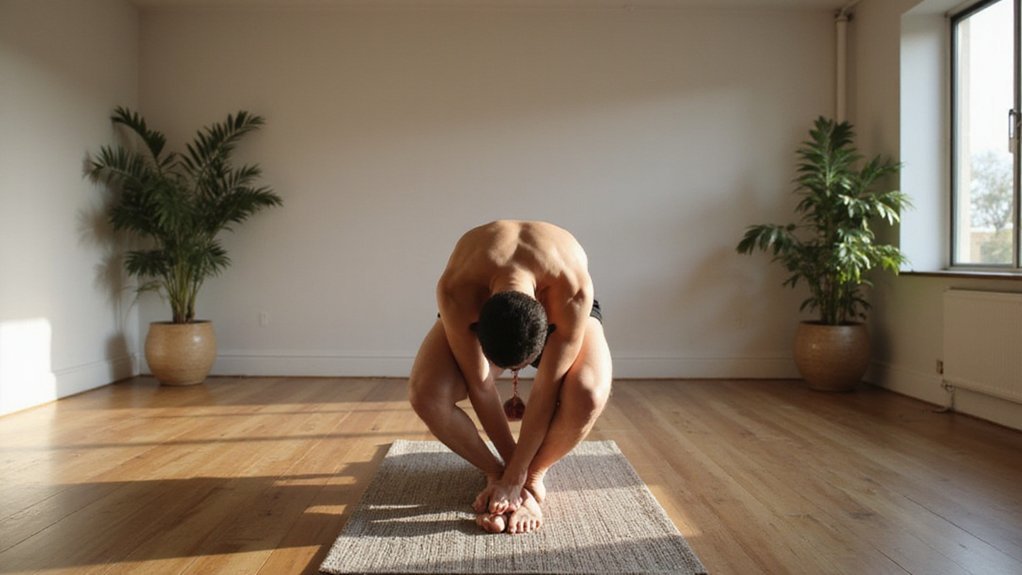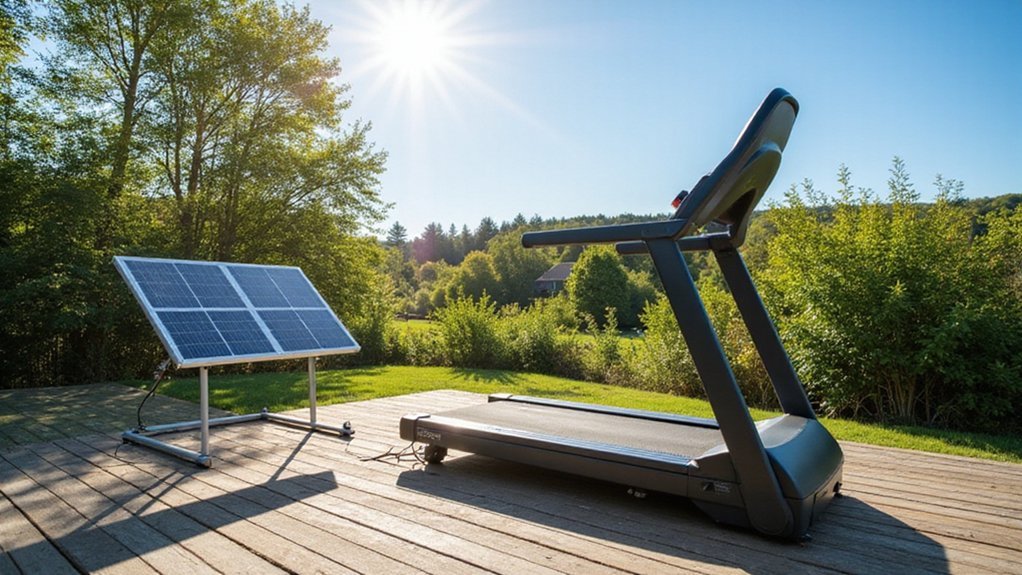Disclaimer: This content is for informational purposes only and does not replace professional medical advice, diagnosis, or treatment. Always consult a qualified healthcare provider before beginning any new exercise program.
Over 65% of strength athletes struggle with chronic muscle tightness and limited mobility. You’ve likely experienced the frustrating plateau where increased strength doesn’t translate to enhanced flexibility. Yin yoga offers a strategic approach to breaking through these physical barriers, promising a holistic method of tissue rehabilitation and performance optimization. If you’re seeking a practice that targets deep connective tissues while simultaneously promoting mental resilience, you’ll want to understand how long-hold stretches can revolutionize your training recovery. Curious about the science behind this transformative technique?
Key Takeaways
- Yin yoga’s long-hold stretches (3-10 minutes) complement strength training by targeting deep connective tissues and enhancing flexibility beyond muscle development.
- Specific poses like Butterfly, Dragonfly, and Swan help lifters address muscle tightness, release tension in hip flexors, hamstrings, and quadriceps.
- Mechanical stress during prolonged stretches stimulates tissue adaptation, improves blood circulation, and promotes gradual elongation of connective tissues.
- Diaphragmatic breathing and mindfulness techniques activate the parasympathetic nervous system, facilitating deeper relaxation and mental resilience during recovery.
- Regular yin yoga practice breaks down fascial restrictions, expands range of motion, and supports joint health for comprehensive athletic performance.
Understanding Yin Yoga for Strength Training
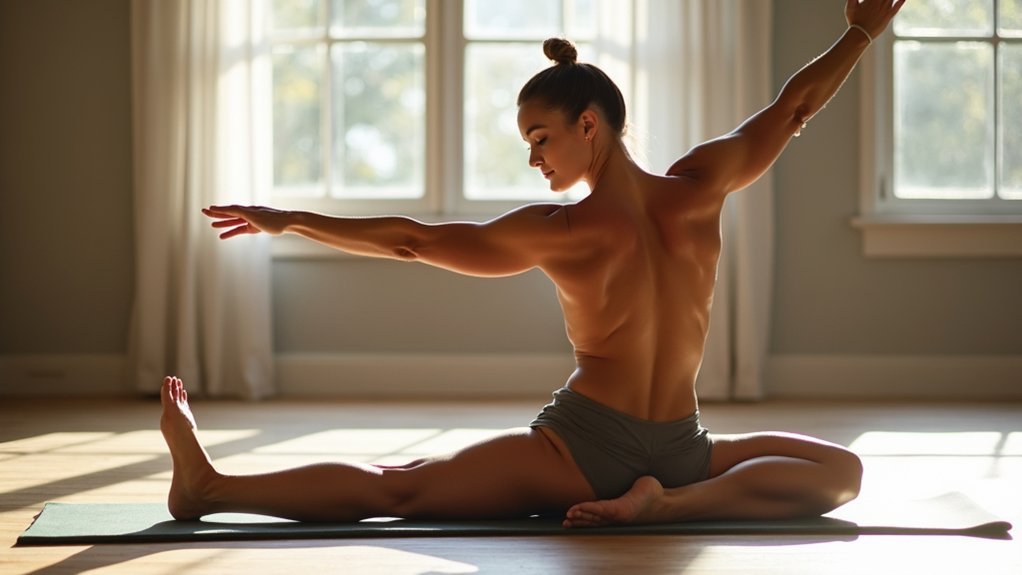
While strength training traditionally focuses on muscle development and power, yin yoga offers a complementary approach that targets the body’s deeper connective tissues. By incorporating long-hold stretches ranging from three to ten minutes, you’ll access a unique method of enhancing flexibility and mobility beyond conventional training techniques. Yin yoga’s passive stretching methodology allows you to systematically release tension in ligaments and fascia without the intense muscular engagement of traditional strength workouts.
This practice isn’t just physical—it’s a holistic approach integrating mindfulness and breath awareness. You’ll develop mental resilience while simultaneously promoting recovery and preventing potential injuries. By strategically integrating yin yoga into your strength training regimen, you’ll reveal a more thorough approach to athletic performance, addressing both physiological and psychological dimensions of your fitness journey.
The Science Behind Long-Hold Stretches
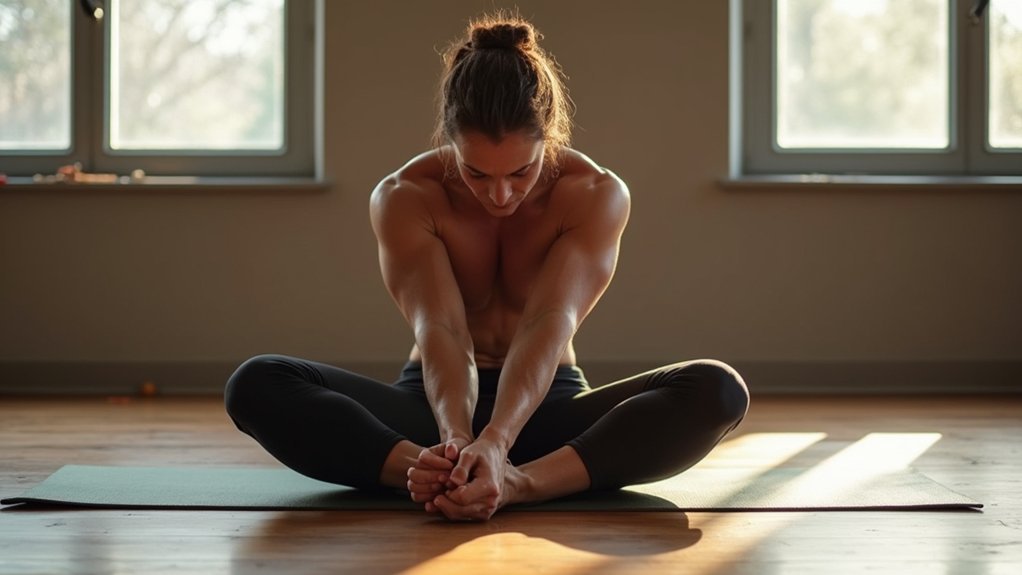
Because mechanical stress plays an essential role in tissue adaptation, long-hold stretches in yin yoga represent a scientifically grounded approach to enhancing flexibility and tissue resilience. These sustained pressure techniques target your body’s deeper structures through a strategic methodology:
Unlock tissue resilience through mindful, prolonged stretching that strategically transforms mechanical stress into adaptive flexibility.
- Bypassing the stretch reflex by maintaining postures for extended periods, allowing connective tissues to elongate gradually
- Stimulating blood circulation to improve nutrient delivery and metabolic waste removal
- Cultivating mindfulness by encouraging focused attention on body’s sensations and breath
The principle of “time over intensity” transforms your flexibility practice from a mere physical exercise to a holistic approach of deep muscle relaxation. By engaging in long-hold stretches, you’re not just improving range of motion, but also creating a profound mind-body connection that supports your strength training goals.
Top 6 Yin Yoga Poses for Lifters
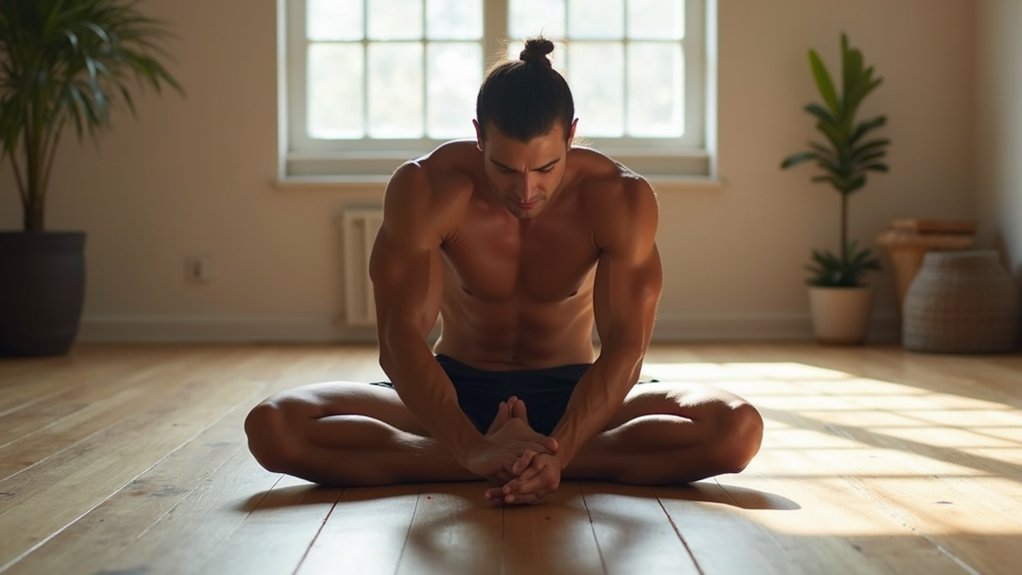
Strategically selected yin yoga poses can dramatically transform a lifter’s recovery and mobility potential. These six targeted stretches address deep connective tissues and muscular tension, enhancing flexibility and performance. Butterfly Pose opens hip flexors, while Dragonfly Pose targets hamstrings and lower back tension. Sphinx Pose releases spinal compression, improving thoracic mobility. Swan Pose addresses quadriceps and hip rotator tightness, promoting joint health. Frog Pose provides intense inner thigh and groin stretching, critical for lifters’ lower body recovery. Supported Fish Pose counteracts chest and shoulder restrictions from repetitive lifting movements.
Breathing and Mindfulness Techniques
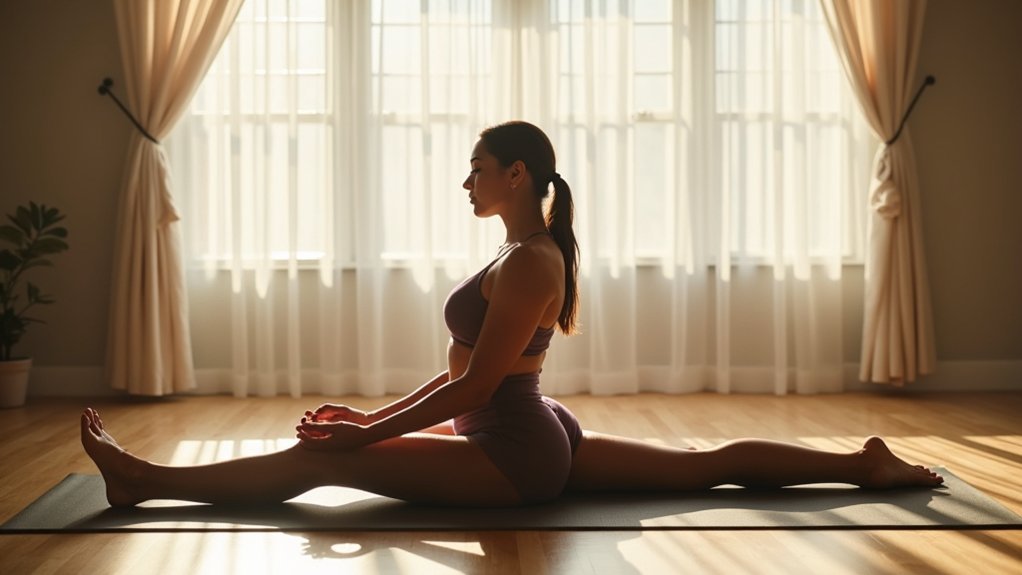
As lifters explore yin yoga, breathing and mindfulness techniques become critical mechanisms for transforming physical practice into a holistic recovery experience. These techniques optimize mental and physiological adaptation during long-held stretches:
- Diaphragmatic breathing activates the parasympathetic nervous system, promoting deep relaxation and reducing sympathetic stress responses while enhancing overall recovery potential.
- Synchronizing breath with movement allows practitioners to draw attention away from discomfort, facilitating deeper body awareness and enabling more profound stretch engagement.
- Maintaining stillness and observing body sensations without judgment cultivates self-awareness, helping lifters develop mental resilience and introspective capabilities during deep stretches.
Recovery and Mobility Benefits
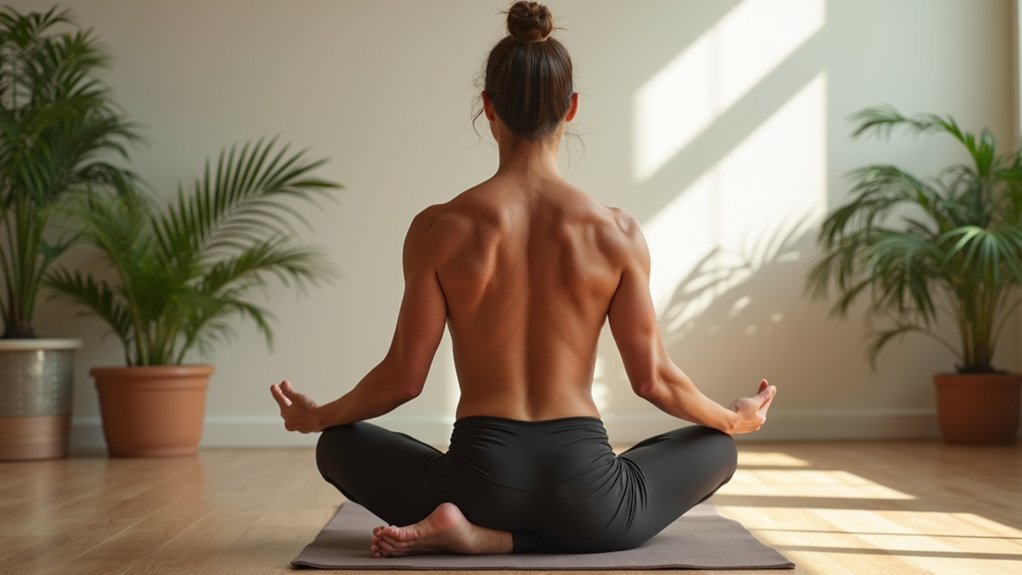
Building upon the mindful breathing techniques that prime the body for deeper work, yin yoga emerges as a potent recovery methodology for lifters seeking enhanced mobility and tissue resilience. By holding stretches for extended periods, you’ll target deep connective tissues, alleviating muscle stiffness and expanding range of motion. These long-hold yoga postures systematically break down fascial restrictions, promoting flexibility and accelerating recovery between intense training sessions. The deliberate, sustained stretching directly addresses joint health, enabling more thorough muscular adaptation and reducing potential injury risks. Yin’s unique approach facilitates parasympathetic nervous system activation, creating a holistic relaxation response that supports physiological healing. For lifters committed to peak performance, integrating yin yoga becomes a strategic intervention, transforming recovery from a passive process into an intentional, targeted practice of tissue restoration and mobility enhancement.
Integrating Yin Yoga Into Your Training Routine
While powerlifting and weightlifting demand intense muscular exertion, integrating yin yoga requires a deliberate, systematic approach that complements your existing training protocol. Consider these strategic implementation methods:
- Schedule daily 15-minute yin yoga sessions post-workout or on recovery days, focusing on long-hold poses targeting muscle groups stressed during lifting.
- Utilize props like blocks and straps to enhance comfort and support during challenging stretches, enabling deeper tissue engagement and improved flexibility.
- Prioritize mindfulness and breath awareness during practice, transforming yin yoga from a passive recovery technique into an active performance enhancement tool.
Your yin yoga practice should emphasize holding poses for 3-10 minutes, promoting oxygen flow, reducing injury risk, and cultivating mental clarity. By approaching yin yoga systematically, you’ll develop a holistic recovery strategy that complements your strength training regimen.
Frequently Asked Questions
Is Yin Yoga Good for Weight Lifters?
Yes, yin yoga’s perfect for you. You’ll enhance muscle recovery, boost flexibility, prevent injuries, and release tension while improving joint mobility. It’s a mindful practice that’ll balance your intense lifting routine, helping you breathe, recover, and grow stronger.
How Long Should You Hold Yin Yoga?
A powerlifter’s journey reveals yin yoga’s transformative potential: You’ll want to hold poses 3-5 minutes, targeting deep connective tissues, enhancing muscle recovery, and improving flexibility through mindful, breath-controlled stretching that prevents injuries and promotes holistic healing.
What Is the Yoga Where You Hold Poses for a Long Time?
Yin Yoga is the practice where you’ll hold poses for 3-20 minutes, targeting deep connective tissues. You’ll experience long-hold benefits like muscle recovery, enhanced flexibility, stress relief, and improved joint health through mindful, breath-aware stretching.
Is It Good to Do Yin Yoga After a Workout?
You’ll enhance recovery benefits and muscle relaxation by practicing yin yoga post-workout. It’ll improve flexibility, prevent injuries, and promote deep breathing. This mindfulness practice supports joint mobility, reduces stress, and provides emotional release through intentional, long-held stretches.
Conclusion
Like a blacksmith tempering steel, you’ll forge resilience through yin yoga‘s deliberate stretches. You’re not just elongating muscle fibers, but restructuring your body’s architectural blueprint. By surrendering to prolonged poses, you’ll reveal deeper mobility, transforming potential rigidity into fluid strength. This practice isn’t merely physical—it’s a holistic recalibration, where breath becomes your internal compass and stillness your strategic weapon. Embrace yin yoga, and you’ll transcend conventional training limitations.
